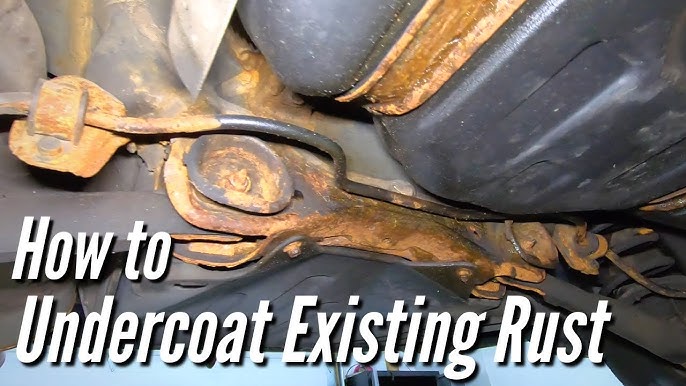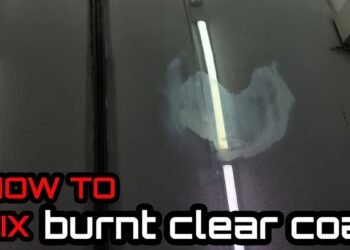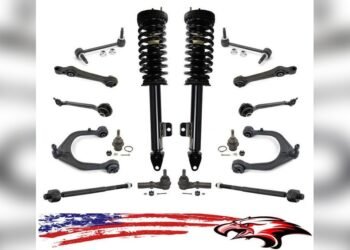If you want to keep your truck looking great and running strong for years, protecting it from rust is key. That’s where Fluid Film undercoat comes in.
This special coating acts like a shield, stopping moisture and salt from eating away at your truck’s frame and underbody. Whether you drive through Austin’s wet winters or dusty roads, applying Fluid Film undercoat can save you costly repairs and keep your truck in top shape.
Curious how it works and why it’s a smart choice for your truck? Keep reading to find out everything you need to know about Fluid Film undercoating and how it can protect your investment.
Fluid Film Basics
Understanding Fluid Film basics helps you protect your truck from rust and damage. This product works as a strong undercoat to shield metal parts. It forms a protective layer that lasts long and prevents corrosion.
Below are key details about Fluid Film, its ingredients, and how it guards your truck.
What Is Fluid Film
Fluid Film is a rust-preventive coating used mainly on vehicles. It is a thick, oily substance that sticks well to metal surfaces. The product is soft and flexible, allowing it to move with the metal. It does not dry hard or crack over time. Many truck owners use it to protect frames and underbodies.
Key Ingredients And Properties
Fluid Film is made from lanolin, a natural oil from sheep’s wool. This ingredient helps it stay wet and slippery. It also contains petroleum-based oils that increase rust resistance. The product repels water and salt, which cause corrosion. Fluid Film spreads easily and clings tightly to metal. It remains effective in cold and wet weather.
How It Protects Against Rust
Fluid Film creates a barrier that blocks moisture and air from reaching the metal. This stops rust from forming on your truck’s frame and parts. It also displaces existing water and prevents salt damage. The coating stays soft, so it keeps protecting even if the metal bends. Regular application ensures long-term rust protection.
Choosing Fluid Film For Trucks
Protecting a truck’s underbody is essential for long-term durability. Rust and corrosion can cause costly damage. Fluid Film offers a unique option for truck undercoating. Its formulation helps guard metal parts from moisture and salt. Many truck owners prefer it for reliable protection and ease of use.
This product penetrates well and stays flexible over time. It creates a barrier that prevents rust from forming. Choosing the right undercoat can extend the life of your truck. Fluid Film stands out due to its proven performance and simple application.
Benefits For Truck Undercoating
Fluid Film protects against rust and corrosion effectively. It is a non-drying formula that remains soft and flexible. This flexibility helps it resist cracking and peeling. The product also lubricates metal parts to reduce wear. It works well in harsh weather and road salt conditions. Fluid Film is easy to apply with spray or brush. It penetrates seams and hard-to-reach areas. The coating lasts for years with minimal maintenance.
Comparing Fluid Film To Rubberized Undercoatings
Rubberized undercoatings form a hard, thick layer on the truck. They can crack and chip over time, exposing metal. Fluid Film stays soft and self-heals minor scratches. It does not trap moisture under the coating. Rubberized products may trap water, causing rust. Fluid Film penetrates deeper into metal pores. It offers longer-lasting protection against corrosion. The ease of removal also favors Fluid Film for reapplication.
When To Use Fluid Film
Apply Fluid Film during truck maintenance or before winter. It is ideal for trucks in salty or wet environments. Use it on older trucks to stop existing rust spread. New trucks benefit from early protection to prevent rust. Fluid Film works well for areas prone to abrasion. Reapply every year or after heavy cleaning. It is suitable for frames, wheel wells, and chassis. This product fits both DIY and professional use.
Preparing Your Truck
Preparing your truck is a key step before applying Fluid Film undercoat. Proper preparation ensures the undercoat sticks well and protects effectively. Taking time now helps avoid issues like peeling or rust later.
Cleaning And Surface Prep
Start by cleaning the truck’s underbody thoroughly. Remove dirt, mud, and grease using a pressure washer or strong detergent. Clean surfaces allow the undercoat to bond better. Dry the area completely before moving forward.
Removing Old Coatings And Rust
Check for any old undercoating or rust spots. Use a wire brush or sandpaper to remove loose rust and peeling coatings. For heavy rust, consider a rust remover or rust converter. Clean metal surfaces are essential for long-lasting protection.
Safety Precautions
Wear gloves and safety glasses during preparation and application. Work in a well-ventilated area to avoid inhaling fumes. Protect your skin and eyes from chemicals and debris. Keep a fire extinguisher nearby, especially if using power tools or heat.

Credit: fluidfilm.com.au
Application Techniques
Applying Fluid Film undercoat to a truck requires the right techniques for best results. Proper application ensures strong protection against rust and corrosion. This section explains key steps and tips for effective use of Fluid Film on trucks.
Heating And Spraying Fluid Film
Fluid Film thickens in cold weather. Heating it softens the product, making spraying easier. Use a warming cabinet or heat gun to reach the right temperature. Avoid overheating to prevent damage. Spray evenly using an air sprayer for smooth coverage. This method reaches hard-to-access parts under the truck.
Using Aerosol Vs Gallon Cans
Aerosol cans offer convenience and ease of use. They are perfect for small touch-ups or tight spots. Gallon cans work well for larger jobs and full truck coverage. Use a spray gun with gallon cans for faster application. Choose the right container based on your project size and accessibility.
Coverage Areas On Trucks
Focus on the truck’s frame, wheel wells, and undercarriage. These areas face the most exposure to water and salt. Also coat suspension parts and inside door panels if possible. Avoid spraying brakes and exhaust components. Proper coverage prevents rust from starting and spreading.
Recommended Thickness And Multiple Coats
Apply Fluid Film in thin, even layers. Too thick a coat can drip or remain sticky. Multiple thin coats provide better protection and drying time. Allow each coat to dry before applying the next. Two to three coats usually create a durable barrier against corrosion.
Estimating Fluid Film Quantity
Estimating the right amount of Fluid Film undercoat for your truck helps save money and ensures full protection. Applying too little may leave parts exposed to rust. Using too much wastes product and creates a mess. Knowing how to measure the quantity needed makes the process smooth and effective.
This guide covers important factors to consider, how to calculate based on truck size, and tips for efficient use of Fluid Film undercoat.
Factors Affecting Amount Needed
Truck size directly impacts how much Fluid Film you need. Larger trucks require more product than smaller ones. The application method matters too. Spraying with a gun uses more Fluid Film than aerosol cans. Thicker coats need more product to cover surfaces well. Rusty or rough surfaces soak up more undercoat, increasing usage. Environmental conditions like temperature can also affect how Fluid Film spreads and dries.
Calculating Based On Truck Size
Measure the total underbody area of your truck to estimate Fluid Film quantity. Full-size trucks often need around one to two gallons for a complete coat. Mid-size trucks usually require less, about half to one gallon. Crew cabs and extended models need more coverage. Check the manufacturer’s recommendations for specific amounts. Keep in mind, some overspray or extra application may be necessary for full protection.
Tips For Efficient Use
Use a proper sprayer for even coverage and less waste. Warm Fluid Film before applying to improve flow and adhesion. Apply in thin, even layers rather than thick coats. Focus on areas prone to rust, such as wheel wells and frame rails. Clean surfaces before application to help the undercoat stick better. Store leftover Fluid Film correctly to prevent drying out or contamination.

Credit: www.youtube.com
Maintaining Protection
Maintaining protection on your truck with Fluid Film undercoat ensures long-lasting rust prevention. This protective layer acts as a barrier against moisture and salt. Keeping it in good condition helps extend your truck’s life and keeps it looking strong.
How Often To Reapply
Reapply Fluid Film undercoat every 6 to 12 months. Trucks exposed to harsh weather or road salt may need more frequent applications. Check the condition of the coating regularly to decide the best time to reapply. A fresh layer keeps corrosion away and maintains protection.
Inspecting For Wear And Damage
Inspect the undercoat at least twice a year. Look for cracks, peeling, or bare spots where the coating has worn off. Pay close attention to wheel wells, frame rails, and other exposed areas. Early detection of damage helps prevent rust from forming underneath.
Addressing Problem Areas
Spot-treat any worn or damaged areas immediately. Clean the surface to remove dirt and rust before applying Fluid Film. Use a brush or spray for even coverage. Fixing problem spots early stops rust from spreading and keeps the entire underbody protected.
Pros And Cons
Choosing Fluid Film undercoat for your truck comes with several benefits and a few downsides. Understanding these points helps you decide if it fits your needs. This section breaks down the main pros and cons clearly.
Advantages Of Fluid Film Undercoating
Fluid Film offers strong rust protection for truck frames. It forms a thick, oily layer that repels water and salt. This prevents corrosion in harsh weather and road conditions. The product is easy to apply with spray equipment. It also stays flexible and does not crack over time. Fluid Film is non-toxic and safer than many traditional undercoatings. It can be used on new or older trucks to extend their life. The coating also reduces squeaks and rattles from loose parts.
Potential Drawbacks
Fluid Film’s oily texture can attract dirt and dust. This may cause the undercoat to look messy. It does not harden like some rubberized coatings, so it may need reapplication. The product can drip during application if not applied carefully. It also has a strong odor that some users find unpleasant. Fluid Film may not provide thick mechanical protection against stone chips. It is best for corrosion resistance rather than impact resistance.
Cost Considerations
The price of Fluid Film varies by quantity and supplier. Buying in gallons lowers the cost per application. The initial investment might be higher than cheaper sprays. However, the long-term rust protection can save money on repairs. Professional application costs add to the total expense. DIY users save money but need proper tools for even coverage. Overall, Fluid Film is a cost-effective option for corrosion prevention.
Additional Tips And Tricks
Applying Fluid Film undercoat on your truck provides excellent rust protection. To get the best results, follow some additional tips and tricks. These simple steps help improve the application process and extend the life of the coating. Proper tools, avoiding errors, and maintaining the coating are key.
Best Tools And Equipment
Use a spray gun for even Fluid Film coverage. A heated spray system helps keep the fluid at the right consistency. Wear gloves and safety glasses to protect your skin and eyes. A wire brush can remove loose rust before applying the coating. A good compressor ensures steady air pressure for spraying. Have rags nearby to clean drips or spills quickly.
Avoiding Common Mistakes
Do not apply Fluid Film on a wet or dirty surface. Dirt and moisture reduce adhesion and protection. Avoid applying too thick a coat; it can drip and take longer to dry. Do not rush the drying time between layers. Always follow the product instructions for best results. Avoid spraying in windy or rainy weather to prevent uneven coverage.
Enhancing Longevity Of Coating
Clean the truck’s underbody before applying Fluid Film. Remove dirt, oil, and loose rust to improve bonding. Reapply Fluid Film every 6 to 12 months for continued protection. Check for scratches or worn spots and touch them up quickly. Store leftover Fluid Film in a cool, dry place to keep it usable. Regular inspections help catch rust early before it spreads.

Credit: www.amazon.com
Frequently Asked Questions
Is Fluid Film Good For Undercoating Cars?
Fluid Film is excellent for undercoating cars. It prevents rust and corrosion by creating a durable, flexible protective layer. Its petroleum-based formula penetrates metal surfaces, offering long-lasting protection against moisture and salt damage. Applying Fluid Film helps maintain your vehicle’s underbody in harsh conditions.
How Many Gallons Of Fluid Film To Undercoat A Truck?
To undercoat a full-size truck, use about 1 to 2 gallons of Fluid Film. Larger trucks may need more. Apply evenly for best rust protection.
How Long Does Fluid Film Last On A Truck?
Fluid Film lasts about 6 to 12 months on a truck, depending on weather and usage. Reapply annually for best rust protection.
What Is The Difference Between Fluid Film And Rubberized Undercoating?
Fluid Film is a petroleum-based, soft, self-healing rust inhibitor. Rubberized undercoating forms a hard, thick, durable protective layer against impacts. Fluid Film penetrates and prevents corrosion; rubberized undercoating blocks moisture and noise. Fluid Film stays pliable; rubberized undercoating can crack over time.
What Is Fluid Film Undercoat For Trucks?
Fluid Film undercoat is a rust-preventive coating that protects truck frames and parts.
Conclusion
Fluid Film undercoat protects your truck from rust and corrosion. It creates a strong barrier that lasts through harsh weather. Applying the right amount ensures full coverage and better protection. Regular use helps maintain your truck’s value and appearance. Choose the application method that fits your needs and truck size.
Protecting your truck’s underbody is a smart step for long-term care. Keep your vehicle safe and running well with Fluid Film undercoat.

















